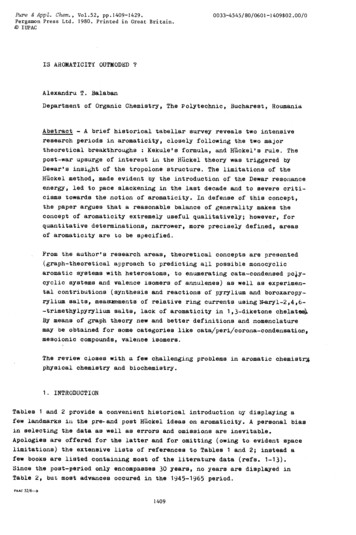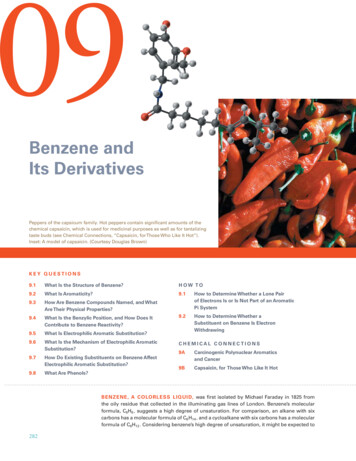
Transcription
Chapter 15: Benzene and AromaticityHHHHHHHHHHHHC6H61MO’s of aC C π-bondπ-antibonding MOπ* 235 KJ/mol-235 KJ/molπ-bonding MOfrom Chapter 1π21
π-molecular orbitals of butadiene3 Nodes0 bonding interactions3 antibonding interactionsANTIBONDING MO2 Nodes1 bonding interactions2 antibonding interactionsANTIBONDING MO1 Nodes2 bonding interactions1 antibonding interactionsBONDING MO0 Nodes3 bonding interactions0 antibonding interactionsBONDING MOψ2 is the Highest Occupied Molecular Orbital (HOMO)ψ3 is the Lowest Unoccupied Molecular Orbital (LUMO)3ψ1 of Butadiene (no nodes, bonding MO)Bonding Interaction The four π-electrons in ψ1 are delocalizedover the four p-orbitals Table 14.2 (p. 528): Bond lengths in pmH3CCH3154H2CCH2133H2C CH CH3149H2C CH CH CH2148H2C CH CH CH213442
π-molecular orbitals of hexatriene!6!5!4six p-orbitals!3!2five nodesfour nodesthree nodestwo nodesone node6 AO’s 6 MO’s!1zero nodes5Conjugation: series of overlapping p-orbitalsAromaticity: cyclic conjugated organic compounds such asbenzene, that exhibit special stability due to resonancedelocalization of π-electrons.63
15.2: Naming aromatic compounds: (arenes)large number on non-systematic names (Table 15.1)CH3benzenetolueneOCH3OHphenolanisoleNH2anilin estyreneGenerally, mono-substituted benzenes are named in a similarmanner as hydrocarbons with -benzene as the thylethyl)benzene(i sopropylbenzene)nitrobenzene7When the benzene ring is a substituent of a parent chain,referred to as a phenyl group. The benzene ring is is regardedas a substituent when the parent chain has greater than sixcarbons. The benzene ring is the parent when the longestalkyl chain substituent is six carbons or 1-methylbutyl)benzeneA phenyl substituent (C6H5-) is often abbreviates as PhA C6H5 -CH2- susbtitutent is often referred to as a benzylgroup (Bn-)ParentchainBenzylgroup84
Disubstituted benzene: relative position of the substitutentsXY1,2-disubstituted:ortho (o-)1,3-disubstituted:meta (m-)1,4-disubstituted:para (p-)XYXYNote: ortho, meta, and para are not used in systematic ylenem-xyleneCl4-chlorobenzoic acidpara-chlorobenzoic acidp-chlorobenzoic acid9Benzenes with two or more substituents:Choose numbers to get lowest possible valuesList substituents alphabetically with hyphenated numbersCommon names, such as “toluene” can serve as rootname (as in TNT)105
15.3: Structure and Stability of BenzeneFormula: C6H6, four degrees of unsaturation (section 6.2)three double bonds one ringThe π-bonds of benzene are resistant to the normal reactionsof alkenes and alkynesBrBr2BrClH ClN o ReactionO3CHOCHOBenzene’s cyclic conjugated structure gives it special stability11Benzene undergoes electrophilic substitution reactions(chapter 16) rather than electrophilic additionBrBr electrophilicadditionBr BrFecatalystBr H BrelectrophilicsubstitutionStability of Benzene: Heats of Hydrogenations H2 118 KJ/mol 2 H2 230 KJ/molcalc'd value 336 KJ/mol6 K J/mol added stability 206 KJ/molcalc'd value 354 KJ/mol148 K J/mol added stability 3 H2126
Structure of Benzene:Kekule benzene: two forms are in rapid equilibrium154 pm134 pm All bonds are 139 pm (intermediate between C-C and C C) Electron density is distributed evenly between the six carbons Structure is planar, hexagonal C–C–C bond angles are 120 Each carbon is sp2 and has a p orbital perpendicular tothe plane of the six-membered ring13Arrows in organic chemistryReaction arrowEquilibrium arrowResonance arrowMechanism arrowsDouble-headed arrowSingle-headed arrow147
Drawing and Interpreting Resonance Forms(chapter 2.5 and 2.6)1.No one resonance forms accurately depicts the structure of the molecule.The real structure is a composite or hybrid of all resonance forms2.Resonance forms differ only by the placement of π- or non-bonding electrons.Neither the position or hybridization of the atoms changes.3.Resonance forms are not necessarily equivalent. While all resonance forms contributeto the actual structure (resonance hybrid), some forms may contribute more.4.All resonance forms must be proper Lewis structures.5.The actual resonance hybrid is more stable than any single resonance form.6.In general, the greater the number of resonance forms, the more stable the resonancehybrid.1515.4: Molecular orbitals of benzenes: (figure 15.3)six AO’s six MO’s!6!4!5!2!3six p-orbitals!1Degenerate orbitals: orbitalsthat have the sameenergyΨ1: zero nodesΨ2 and Ψ3: one nodeΨ4 and Ψ5: two nodesΨ6: three nodeBondingAnti-bonding168
15.5 & 15.8: Aromaticity and the Hückel 4n 2 RuleCyclic conjugated molecules: not all cyclic conjugated systemsare aromatic (no special stability)cyclobutadiene4 !-electronsbenzene6 !-electronsCyclobutadiene: highly reactivetwo different C-C bondscyclooctatetraene8 !-electrons Diels-Alder-78 CCyclooctatetraene: reactivity similar to normal C CExists in a boat-like conformation:little overlap betweendouble bonds17Aromatic:CyclicConjugated: “alternating single and double bonds”Flat: maximum overlap between conjugated π-bondsMust contain 4n 2 π-electrons, where n is an integer(Hückel’s rule)Anti-aromatic:cyclic, conjugated, flat molecules that contain4n π-electrons (where n is an integer).Destabilized (highly reactive) relative to thecorresponding open-chain conjugated system189
Frost Circles: relative energies of the molecular orbitals ofcyclic, conjugated systemsInscribe the cyclic, conjugated molecule into a circle so that avertex is at the bottom. The relative energies of theMO’s are where the ring atoms intersect the circlebenzene:anti-bonding MO'snon-bondinglevelbonding MO'sBenzene6 !-electronsFor aromatic compounds, such as benzene,the bonding MO's will be filled.cyclobutadiene:anti-bonding MOnon-bonding MO'sbonding MOCyclobutadiene4 !-electronsFor anti- aromatic compounds, such ascyclobutadiene, there will be unpairedelectrons in bonding, non-bonding orantibonding MO's.1915.6: Aromatic ionsHH Cl AgBF4HBF4HHHH ClHHH AgClHH AgBF4HHHBF4 AgClH"2HH"3"1H4n 2 2n 0aromaticcyclopropenyl cation2 !-electronsHHHHHcyclopentadienyl cation4 !-electrons"4"5"2"3"14n 4n 1anti-aromatic2010
HH H B:H B:HHH4n 4n 1anti-aromaticHcyclopropenyl anion4 !-electrons"2"3"1HH HHHHHHpK a 15HH B: B:HHcyclopentadienyl anion6 !-electrons"4"5"2"34n 2 6n 1aromatic"121H Br K02-Br-2K 6 π-electron10 π-electron2211
15.7: Aromatic HeterocyclesHeterocycle: any cyclic compound that contains ring atom(s)other than carbon (N, O, S, SOthiazoleoxazoleCyclic compounds that contain only carbon are calledcarbocyclesHeterocyclic aromatic compounds are numerous, commonand a very important class of organic compoundsNomenclature for heterocyclic compounds is specialized 23Pyridineπ-electron structure resembles benzene (6 π-electrons)The nitrogen lone pair electrons are not part of thearomatic system (perpendicular orbital)N6 π-electrons2412
Pyrrole:6 π-electron system similar to that ofcyclopentadienyl anionFour sp2-hybridized carbons with 4 p orbitalsperpendicular to the ring and 4 p electronslone pair of electrons in an sp2 orbital; part of thearomatic sextetNHPyrrole is much less basic than pyridine. Why?2515.9: Polycyclic aromatic hydrocarbons eneflourenePolycyclic line2613
Polycyclic aromatic hydrocarbonsAromatic compounds can have rings that share aset of carbon atoms (fused rings)Compounds from fused benzene or aromaticheterocyclic rings are themselves aromaticNaphthalene: 4n 2 10, n 2 note: Hückels rule is strictlyfor monocyclic aromatic compound, its application topolycyclic aromatic compounds is tenuous.2715.10: Spectroscopy of Aromatic CompoundsIR: Aromatic ring C–H stretching at 3030 cm 1 andpeaks from 1450 to 1600 cm -disubstituted:690-710 cm-1 and 730-770 cm-1735-770 cm-1690-710 cm-1 and 810-850 cm-128810-840 cm-114
UV:1HAbsorbance near 205 nm and a less intense peakin 255-275 nm range. Substitution and increasedconjugation moves the absorbance to longerwavelengthsNMR: Aromatic H’s strongly deshielded by ring andabsorb between δ 6.5 and δ 8.0Peak pattern is characteristic positionsof substituents29C8H9Br3H2H2H2HC9H123H3H4H2H3015
Ring Current: (please read)Aromatic ring oriented perpendicular to a strongmagnetic field, delocalized π electrons producing a smalllocal magnetic fieldOpposes applied field in middle of ring but reinforcesapplied field outside of ringResults in outside H’s resonance at lower field31! -1.0HHHHH! 2.0CCHCHHH H HHHC CCHCHCHCHH3216
13CNMR:Carbons in aromatic ring absorb at δ 110 to 140Shift is distinct from alkane carbons but in samerange as alkene carbons33C9H12C6H4Cl21H1HNMRNMR13C13CNMRNMR3417
13CNMR3618
1,2-disubstituted: ortho (o-) 1,3-disubstituted: meta (m-) 1,4-disubstituted: para (p-) Y X Y X Y X Note: ortho, meta, and para are not used in systematic nomenclaure CH 3 2-ch lorotoluene ortho-chlorotoluene o-chlorotoluene H CH 3 1,3-dim ethylbnz meta-xylene m -xylene CO2H Cl 4- ch orben










